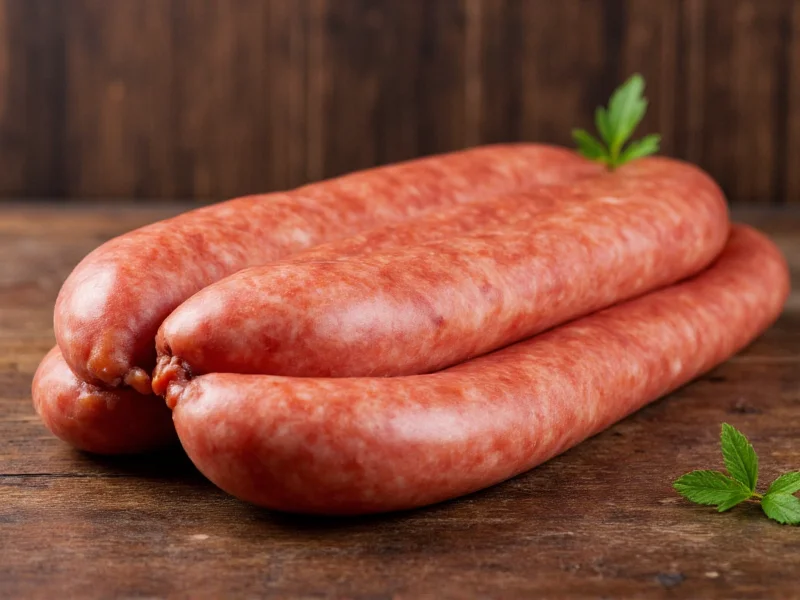Sausage casings serve as the essential outer layer that contains sausage meat during processing and cooking. Understanding what these casings are made of helps both home cooks and professional butchers select the right type for their specific needs, whether creating delicate breakfast links or substantial smoked sausages.
Natural Sausage Casings: The Traditional Choice
Natural casings represent the original sausage casing material, with historical use dating back centuries. These casings come from the submucosal layers of animal intestines, primarily from:
- Hog casings - Sourced from pig intestines, these medium-sized casings (typically 28-34mm diameter) work perfectly for breakfast sausages and bratwursts. Their natural texture allows for that characteristic "snap" when biting into a quality sausage.
- Sheep casings - The smallest natural option (18-24mm), ideal for delicate breakfast links and small snack sausages. Their thin walls provide excellent flavor transfer and a tender bite.
- Beef casings - Including middle and bung casings, these larger options (32-40mm+) suit substantial sausages like salami and summer sausage. Beef middles work well for ring bologna and similar products.
Natural casings require careful preparation before use. Manufacturers clean, salt, and sometimes smoke these casings to preserve them. When properly handled, natural casings create that authentic texture and appearance consumers associate with high-quality sausages. The slight irregularity in natural casings actually contributes to their appeal, providing a traditional look that machine-perfect synthetic casings cannot replicate.
Artificial Sausage Casings: Modern Manufacturing Solutions
As sausage production scaled up in the 20th century, manufacturers developed artificial casings to address consistency and efficiency challenges. These fall into three main categories:
Cellulose Casings
Made from regenerated cellulose (typically from cotton linters or wood pulp), these transparent casings revolutionized sausage production. Cellulose casings come in two varieties:
- Peelable cellulose - Used for fresh sausages like hot dogs, these casings are removed after cooking
- Edible cellulose - Designed to remain on certain products during consumption
The manufacturing process involves dissolving cellulose in chemicals, extruding it into tubes, and regenerating the cellulose structure. This creates a strong, uniform casing that withstands high-speed filling equipment. Most hot dogs you purchase use cellulose casings that are removed during processing, giving that smooth, consistent appearance.
Collagen Casings
Derived from animal collagen (usually bovine hides), these casings offer a middle ground between natural and fully synthetic options. The production process involves:
- Extracting collagen from raw materials
- Processing it into a viscous solution
- Extruding and drying into tubular form
Collagen casings provide several advantages over natural options:
- Consistent diameter throughout the casing length
- Available in various sizes for different sausage types
- Most are edible, eliminating the need for removal
- More economical than natural casings for commercial production
| Casing Type | Diameter Range | Primary Uses | Edible? |
|---|---|---|---|
| Sheep Casings | 18-24mm | Breakfast links, snack sticks | Yes |
| Hog Casings | 28-34mm | Bratwurst, Italian sausage | Yes |
| Beef Casings | 32-40mm+ | Salami, summer sausage | Yes |
| Collagen Casings | 16-40mm | Variety of sausages | Mostly yes |
| Cellulose Casings | 18-36mm | Hot dogs, frankfurters | Sometimes |
Fibrous Casings
Made from cellulose fibers reinforced with paper backing, these sturdy casings serve specialty purposes:
- Used for large-diameter products like salami and pepperoni
- Withstand long smoking and drying processes
- Often printed with branding information
- Not edible - must be removed before consumption
Vegetarian and Vegan Sausage Casing Alternatives
As plant-based diets grow in popularity, several casing options now accommodate vegetarian and vegan preferences:
- Alginate casings - Made from seaweed extracts, these work well for some vegetarian sausages
- Modified cellulose - Vegan-friendly plant-based options that mimic traditional textures
- Edible films - Newer plant-protein based casings designed specifically for meat alternatives
While these options continue improving, many vegetarian sausage producers still use traditional cellulose casings since they're plant-based by nature. The challenge remains creating casings that provide the same cooking properties and texture as animal-derived options.
How Casing Material Affects Sausage Quality
The choice of casing significantly impacts the final sausage product:
- Texture - Natural casings provide that desirable "snap" when biting, while some artificial options create a smoother texture
- Moisture control - Different casings allow varying amounts of moisture exchange during smoking and cooking
- Flavor development - Natural casings permit better smoke penetration and flavor development
- Cooking behavior - Some casings shrink more during cooking, affecting the sausage's appearance
Professional sausage makers select casings based on the specific product requirements. For example, a high-quality bratwurst typically uses natural hog casings for authentic texture, while commercial hot dogs often use cellulose for consistency and processing efficiency.
Selecting the Right Casing for Your Needs
When choosing sausage casings, consider these factors:
- Product type - Match casing diameter to your sausage recipe
- Processing method - Smoking, drying, or fresh consumption requires different casing properties
- Desired texture - Natural casings provide more traditional bite
- Scale of production - Home cooks often prefer natural casings, while commercial producers may favor consistency of artificial options
- Dietary requirements - Consider vegetarian/vegan needs when selecting materials
For home sausage making, natural casings typically offer the most satisfying results despite requiring more preparation. They're available from butchers, specialty food stores, and online retailers, usually sold in salted or pre-flushed forms for convenience.











 浙公网安备
33010002000092号
浙公网安备
33010002000092号 浙B2-20120091-4
浙B2-20120091-4